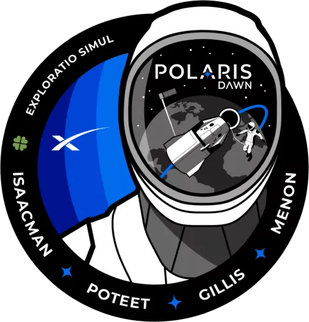On this page: Polaris Dawn Mission Van Allen Belts > Space Environment Research >Suits and Space Walks > Polaris Mission 2 and 3 > Microgravity Research > Polaris Dawn Web Resources
Polaris Dawn Mission
The Polaris program is a follow-on mission to the highly successful Inspiration-4, the first SpaceX civilian mission. Jared Isaacman is funding a large part of the mission. Isaacman is working to open up space for everyone, making humankind a multi-planetary species, and bringing back benefits for humans on Earth. The Inspiration 4 mission garnered $263 million for St. Jude Children's Research Hospital. Three Ppolaris missions are planned.
Polaris Dawn Mission - 1

Announced in February 2022, the Polaris Dawn mission was a private human spaceflight mission, to be housed in SpaceX’s Crew Dragon spacecraft. The mission will be conducted under the Polaris Program. The mission raised donations and awareness for St. Jude Children's Research Hospital and other charitable causes. Polaris Dawn was the first of three human spaceflight missions intended to demonstrate new technologies and conduct microgravity research.
Polaris Dawn was launched on SpaceX’s Falcon 9 rocket from NASA Kennedy Space Center from the Launch Complex 39A on September 10. The crew consisted of Jared Isaacman, Scott Poteet, and SpaceX employees, Sarah Gillis, and Anna Menon. The four astronauts flew in a SpaceX Crew Dragon spacecraft named, Resilience, living in orbit for five days. Commander Jared Isaacman conducted the first spacewalk by a private citizen on September 12, at 6:52 a.m. EDT. SpaceX has provided Crew Dragon with a structure of rails and handholds that they have named, "Skywalker." About eight minutes later, mission specialist Sarah Gillis also went out of the capsule for a spacewalk. They tested the mobility of the SpaceX’s extravehicular activity or EVA suit while standing in the hatch as the spacecraft orbited planet Earth.
On September 15 at 3:37 a.m. EDT, Resilience splashed down near the Dry Tortugas, in the Gulf of Mexico west of Key West, a landing site that had never been used before. The spacecraft landed there due to weather conditions at other locations.
The Polaris Dawn crew members include entrepreneur, pilot, and philanthropist Jared Isaacman, mission pilot Scott Poteet; and SpaceX employees, Sarah Gillis, and Anna Menon. Anna Menon works for SpaceX in Mission Control. Sarah Gillis, mission specialist, is a lead astronaut trainer. Jared Isaacman is funding much of the Polaris mission privately.
The Polaris Dawn mission flew the Crew Dragon into a 56-degree elliptical orbit around the Earth. Resilience reached an altitude of 870 miles or 1,400 kilometers. above Earth, the highest orbit obtained by humans since the Apollo program This surpassed the previous record held by Gemini 11 astronauts, Charles Conrad and Richard Gordon, who orbited 853 miles above Earth in September 1966.
Polaris Dawn carried out a technology demonstration by communicating with ground controllers on Earth using the Starlink Satellite system that SpaceX has been launching since 2019. The Dragon spacecraft orbited above the Starlink satellites. By using laser communications through the Starlink network, the Polaris Dawn crew was to able to provide high-quality livestreams during the mission. Polaris Dawn also featured the first commercial spacewalk, ever!
Studying Earth's Van Allen Belts
During the mission, the Crew Dragon orbited through portions of the Van Allen Radiation Belts. The Van Allen belts surround the Earth with a zone of energetic charged particles that originate from the solar wind. The charged particles are captured by Earth's magnetosphere. Earth has two belts that extend from an altitude of ~400 to 36,040 miles (~640 to 58,000 km ) above the surface. In the belts, the radiation levels vary. Most of the particles that form the belts are thought to come from solar wind and the other particles by cosmic rays. By trapping these particles, Earth's magnetic field protects the atmosphere, allowing life on Earth to flourish. Polaris Dawn conducted research on the Van Allen Belts and studied the effects of spaceflight and space radiation on human health.
Space Environment Research
In addition to gathering data on the radiation environment to improve understanding of how space radiation affects human biological systems, the crew studied human decompression sickness. Crew members wore special, smart contact lenses designed to measure pressure in the eye to advance knowledge of Spaceflight Associated Neuro-Ocular Syndrome described below. This is additional to the body of research done on the Inspiration-4 mission.
Space Omics and Medical Atlas (SOMA) across orbits - Nature Portfolio
The SOMA Atlas includes data for aerospace medicine and space biology collected from over 100 institutions during spaceflights. This issue includes analysis of samples collected by the short-term mission, Inspiration-4, that traveled to a high-altitude orbit of 575 km.
Spacesuits and Spacewalks
During the flight the Polaris Dawn crew studied the spacesuits that SpaceX is developing for space missions on their Starship spacecraft. The Polaris Dawn mission included the first citizen spacewalk or extravehicular activity (EVA). Because they made the first citizen spacewalk, the suits had to be very carefully tested for their ability to protect humans from the harsh environment in space. Since the Crew Dragon spacecraft has no airlock that required the entire capsule be depressurized during the spacewalk. Commander Jared Isaacman and mission specialist Sarah Gillis separately floated out of the hatch and remained tethered to the spaceship at an altitude of ~300 miles, or ~700km above Earth's surface. While each astronaut performed the walk, the other three remained in the spacecraft.
- - Visit the Polaris Dawn main web page.
Polaris Dawn Mission 1 Resources
St. Judes' Polaris Dawn web site.
Polaris Dawn crew, SpaceX discuss upcoming Dragon mission - full news conference - Spaceflight Now full interview (1:17:51)
SpaceX Polaris Dawn Mission Postings
SpaceX Launches webpage featuring the Polaris Mission with additional launch schedule details and other flight information
SpaceX's Polaris Mission features a spacewalk that is simulated in this post at X.com. Astronauts will be facing toward the Earth with the spacecraft above them. They will always be tethered to the vehicle and will not fly free.
Other Resource Links
Polaris Dawn astronauts to attempt historic first commercial spacewalk, Starlink demonstration - Spaceflight Now
A deeper look at the four commercial astronauts of the Polaris Dawn mission and the experiments and activities aboard the Dragon
SpaceX Astronauts Will Fly Higher Than Any Human Has This Century Scott Manley youTube video. More details on the orbit and mission of Polaris Dawn
Check out the A conversation with Jared Isaacman about Polaris, Starship and his upcoming EVA! Everyday Astronaut, Tim Dodd, YouTube video interviewing Jared Isaacman in 2022.
- - find out more about SpaceX at Astra's Stargate
☆ ☆ ☆
Polaris Mission - 2
The second mission will help to determine how to make the Starship Crew cabin efficient and comfortable for the third Polaris mission that will be the first crewed flight of SpaceX’s Starship with humans on board.
Polaris Mission - 3
The third mission will be the first crewed test of the SpaceX Starship. This means that Starship will be ready to ferry humans to space. Before this mission can happen, the spacecraft will have to be human-rated. On to the Moon and Mars!
- - More information will be added to this site as it becomes available.
Microgravity Research
The Translational Research Institute for Space Health (TRISH) is part of a NASA/academia consortium led by Baylor College of Medicine in Houston, TX. Baylor's Center for Space Medicine has a website for the Polaris Dawn Mission.
The Polaris Program has other partners in microgravity research that can be found on their website. The research is designed to advance human health on Earth and improve human health during long space missions. Some of the areas of microgravity research to be carried out by the Polaris Dawn Mission include monitoring astronauts for signs of decompression sickness, studying how the radiation environment in space affects human biological systems, and research into Spaceflight Associated Neuro-Ocular Syndrome (SANS), that causes damage to the eyes due to long-duration spaceflight.
- - Go to the Polaris Program web site.
